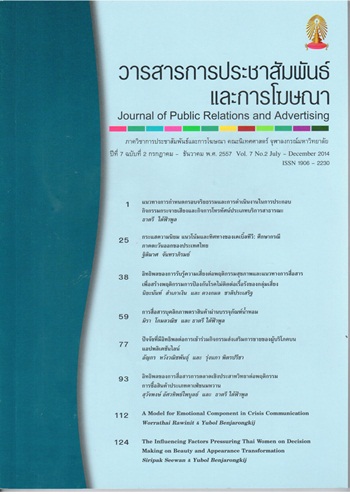กระแสความนิยม แนวโน้มและทิศทางของเคเบิ้ลทีวี: ศึกษากรณีพื้นที่ภาคตะวันออกของประเทศไทย
Main Article Content
Abstract
The purposes of the research were to survey the popular trends of Cable TV audiences, to compare personal and environmental factors to the popular trends of Cable TV audiences, and to acknowledge the tenors or directions of the competitions, the situations of technology business, and the themes of TV programs including the directions of Cable TV business in the future during 2012 – 2017.
The research was divided into 2 procedures which were collecting quantitative data from 400 members of Cable TV audiences in 9 provinces in the east of Thailand which were NakornNayok, Samutprakarn, Chachoengsao, Chonburi, Chantaburi, Trad, Rayong, Prachinburi and Sra-keawby using 400 questionnaires in order to acknowledge the popular trends or people’s satisfaction toward Cable TVs and collecting qualitative data by interviewing people in depth in order to know the tenors and directions of Cable TVs from the comments of 22 entrepreneurs of Cable TVs, academic and related people. The analysis of quantitative data applied basic statistics such as percentage, mean, standard deviations and statistics of hypothesis test which were T-Test analysis, analysis of variance and multiple regression by computer programs and analysis of the qualitative data used content analysis.
Research results The people’s popular trends toward Cable TVs were quite high overall. For personal factors including the samples who had different genders and ages, the popular trends were not different and the ones who had different education levels, family status, careers and income, the popular trends were different. For environmental factors including type of the samples’ homes, decision makers in households, numbers of family members, numbers of family members who have jobs, and different levels of income in households, the popular trends were different among them. Overall, the samples that had sufficiency levels of income in households and monthly different expenses of Cable TV member fees, the popular trends had no difference among them. Moreover, three variables including the authority in making a decision, status and number of the family members had an influence or a cause of popular trends for Cable TV audiences. The key informants gave important basic concepts including current situations of high competition of Cable TV business both within and between organizations. Main competitors of Cable TVs follow conditions of current situations. Conditions and limitations of each Cable TV are different, according to the Cable TVs’context. Number of the members and service costs of each Cable TV are different although they are in the same province because of different compositions and factors: geography, areas, popularity, population, services and membership fees, etc. The audiences’ satisfaction, which is members’ tempers in the views of Cable TVs’ entrepreneurs to ward Cable TV programs, was in many issues such as forms of the programs; for example, local news, movies, sports, etc., programs and reasonable prices. Visual and audio signals are clear and accessible. Not to take advantage from clients in services is reasonable prices. Problems and obstacles of running Cable TV business classified into many cases are the views of entrepreneurs and academics including related people; for example, the problems of their competitors, law and regulation, personnel, capital, technology including advantage and disadvantage of Cable TVs which is to broadcast visual and audio signals into communities with good access, to support worthwhile and creative benefits, to approach circumstances and contents more than other frequencies, to be able to acknowledge information, movements, activities within the community through Cable TV media, and to be useful for advantageous and worthwhile development in the community. Moreover, the key informants commented about tenors and directions of Cable TVs. The main issue was survival of Cable TV business. Many people believed that in the near future, not over ten years, Cable TVs could continue their business with many reasons in many respects including investment by itself without any loan, formats and contents of the programs meeting needs of local people, good services and satisfaction from members, etc. Many people agreed with joint ventures of Cable TVs because it could make the merger more powerful, and it could motivate the group's power to participate activities extremely. However, many people did not agree with laws including the channels which NBTC will continue to increase. There must be legal consideration in order to control transmission, broadcast, copyright, and system development to modernization and more attention of interested people. For adaptation including tenors and directions of cable TVs in the next 5-10 years, information and contents of Cable TV programs will have to be developed in every aspect including legalization and regulation, support of local community, and Cable TVs’ personnel development to pursue information and produce programs in a consistency with local people’s needs in the community levels in order to make these communities receive the advantages actually and equality.


